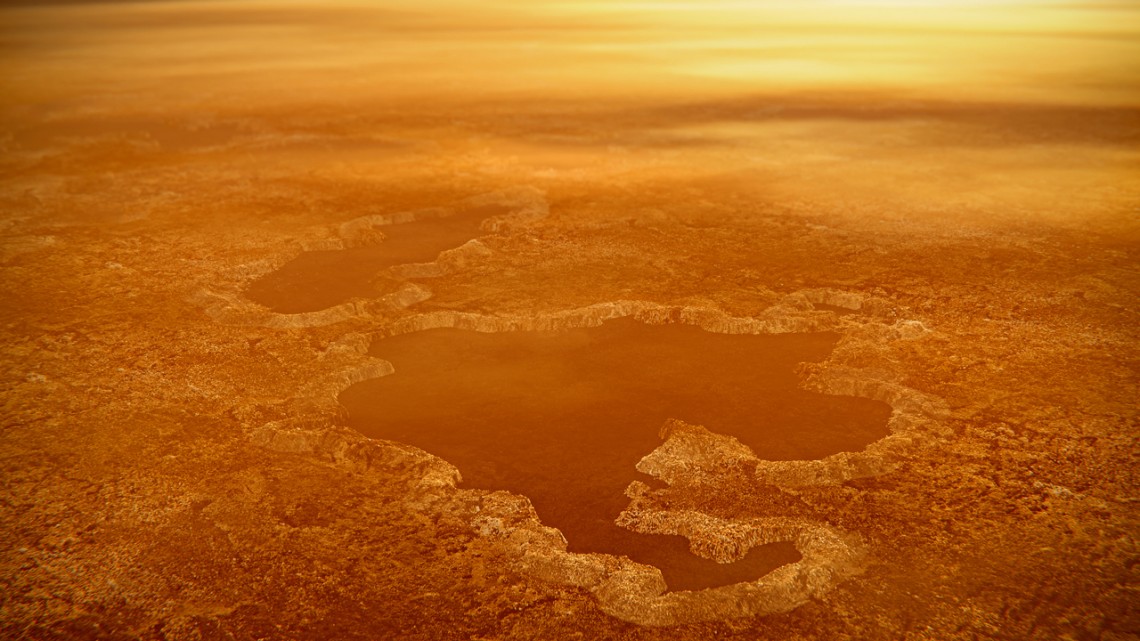
An artist's concept of a lake at the north pole of Saturn's moon Titan illustrates raised rims and rampart-like features such as those seen by NASA's Cassini spacecraft around the moon's Winnipeg Lacus.
Explosive nitrogen created craters that pock Saturn moon Titan
By Blaine Friedlander
The topography of Titan, the largest of moon of Saturn, seems serene in Cassini mission images, but lakes of liquid methane that pock the landscape were likely formed by explosive, pressurized nitrogen just under the moon’s crusty surface, according to research published Sept. 9 in Nature Geoscience.
“Titan has a very distinctive topography. Its lakes show different kinds of shapes and in some cases sharp ridges,” said paper co-author Jonathan Lunine, the David C. Duncan Professor in the Physical Sciences and chair of the Department of Astronomy.
An international group of scientists, led by Giuseppe Mitri of Italy’s d’Annunzio University, examined lakes on Titan’s surface that featured steep, cratered sharp edges, raised rims and ramparts. Some of the steep ridges tower far above the moon’s natural liquid sea level.
“You either need gas that ignites explosively or a gas that builds up enough pressure so that it just pops like a cork from a champagne bottle. On Titan, there is nothing that will create a fiery explosion because that moon has no free oxygen,” said Lunine. “Thus, a pressurized explosion model, we argue, is a better model for those kinds of lakes. Craters are created and they fill with liquid methane.”
Besides Earth, Titan is the only other body in the solar system with a stable liquid – in this case, methane – on its surface. Titan’s atmosphere is filled with vaporized nitrogen.
In Titan’s geophysical history, that moon has seen epochs where methane becomes depleted, leaving a nitrogen atmosphere. The nitrogen cools, Lunine said, producing nitrogen liquid rain in its frigid climate, which then collects in pockets under Titan’s crust.
While Titan is far from the sun, a slight amount of geologic heating might occur that causes this pressurized gas to explode – popping out to the surface. In the moon’s natural cycling process, liquid methane returns and fills the craters to make lakes.
Images for this research were gathered by the radar data from the NASA Cassini mission’s last close flyby of Titan, just months before the spacecraft’s final plunge into Saturn two years ago.
Lunine noted that pressurized explosions occur elsewhere in the solar system. On Neptune’s moon Triton, during the Voyager II mission in 1989, scientists saw this phenomenon in a large polar cap composed of nitrogen.
“We saw these big deposits of nitrogen with streaks of black that looked like cigarette burns on the nitrogen ice,” he said. “It was dust under the nitrogen being heated by the sun, allowing the nitrogen to explode outward.”
In addition to Mitri and Lunine, other co-authors on “Possible Explosion Crater Origin of Small Lake Basins with Raised Rims on Titan,” were postdoctoral researchers Valerio Poggiali at Cornell and Marco Mastrogiuseppe at the California Institute of Technology. NASA provided funding for this research.
Media Contact
Get Cornell news delivered right to your inbox.
Subscribe
